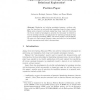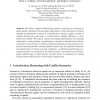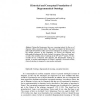103
Voted
ICCS
2007
Springer
15 years 7 months ago
2007
Springer
Designing and refining ontologies becomes a tedious task, once the boundary to real-world-size knowledge bases has been crossed. Hence semi-automatic methods supporting those task...
ICCS
2007
Springer
15 years 7 months ago
2007
Springer
After decades of concurrent development of symbolic and connectionist methods, recent years have shown intensifying efforts of integrating those two paradigms. This paper contribu...
100
click to vote
ICCS
2007
Springer
15 years 7 months ago
2007
Springer
There is a need for information, application, and other enterprise architectures which are robust and flexible enough to meet the challenges of today’s heterogeneous, rapidly cha...
ICCS
2007
Springer
15 years 7 months ago
2007
Springer
Abstract. Representation of knowledge is used to store and retrieve informational data in a machine. Since meaning cannot be directly stored in the computer; this work proposes a s...
101
Voted
ICCS
2007
Springer
15 years 7 months ago
2007
Springer
Abstract. Frames, i.e., recursive attribute-value structures, are a general format for the decomposition of lexical concepts. Attributes assign unique values to objects and thus de...
105
click to vote
ICCS
2007
Springer
15 years 7 months ago
2007
Springer
We build a generic methodology based on learning and reasoning to detect specific attitudes of human agents and patterns of their interactions. Human attitudes are determined in te...
105
click to vote
ICCS
2007
Springer
15 years 7 months ago
2007
Springer
We briefly give an overview of Dynamic Epistemic Logic (DEL), mainly in semantic terms. We focus on the simplest of epistemic actions in DEL, called public announcements. We also ...
ICCS
2007
Springer
15 years 7 months ago
2007
Springer
This paper presents a Conceptual Graph (cg) framework to the Generation of Referring Expressions (gre). Employing Conceptual Graphs as the underlying formalism allows a new rigorou...
109
click to vote
ICCS
2007
Springer
15 years 7 months ago
2007
Springer
Abstract. Many knowledge representation mechanisms consist of linkbased structures; they may be studied formally by means of unordered trees. Here we consider the case where labels...
ICCS
2007
Springer
15 years 7 months ago
2007
Springer
During the Renaissance there was a growing interest for the use of diagrams within conceptual studies. This paper investigates the historical and philosophical foundation of this r...



